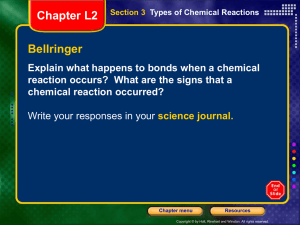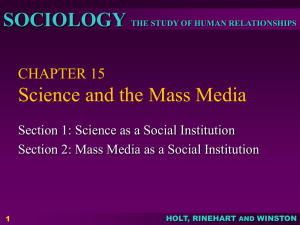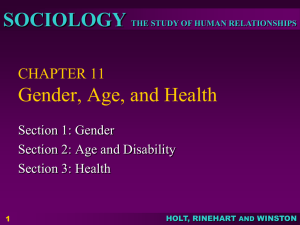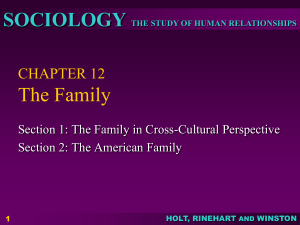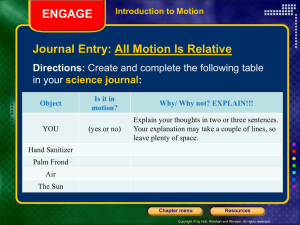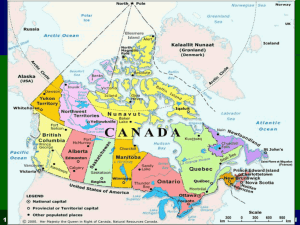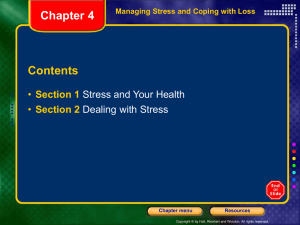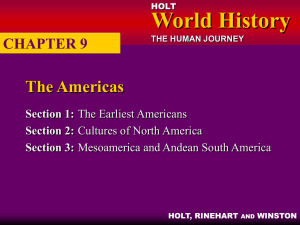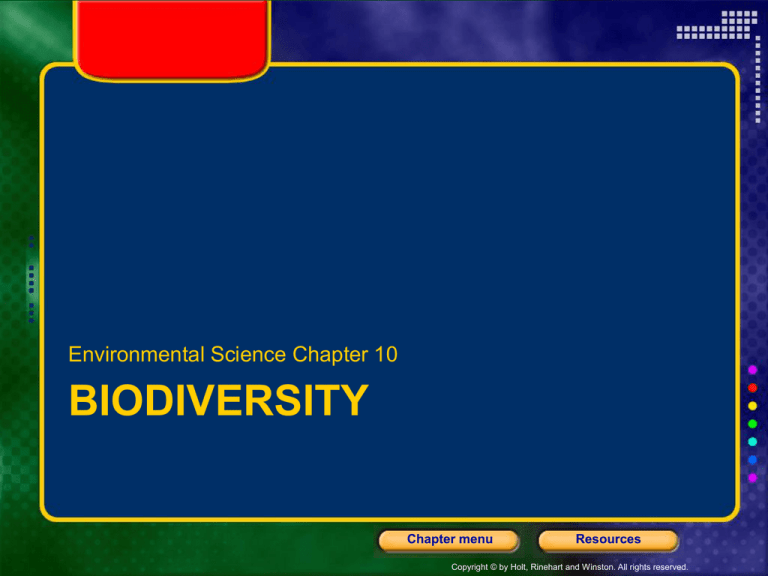
Environmental Science Chapter 10
BIODIVERSITY
Chapter menu
Resources
Copyright © by Holt, Rinehart and Winston. All rights reserved.
Chapter 10
Biodiversity
Table of Contents
Section 1 What Is Biodiversity?
Section 2 Biodiversity at Risk
Section 3 The Future of Biodiversity
Chapter menu
Resources
Copyright © by Holt, Rinehart and Winston. All rights reserved.
Chapter 10
Section 1 What is Biodiversity?
Key Questions
• What is meant by biodiversity? What is the difference between
known species and estimated species?
• What are three levels of biodiversity?
• In what ways is biodiversity important to ecosystems and
humans?
• What is the potential value of a single species?
Chapter menu
Resources
Copyright © by Holt, Rinehart and Winston. All rights reserved.
Chapter 10
Section 1 What Is Biodiversity?
A World Rich in Biodiversity
• Biodiversity stands for biological diversity,
– variety of organisms in a given area,
– genetic variation within a population,
– variety of species in a community,
– or the variety of communities in an ecosystem.
• Humans need to understand and preserve
biodiversity for our own survival.
Chapter menu
Resources
Copyright © by Holt, Rinehart and Winston. All rights reserved.
Chapter 10
Section 1 What Is Biodiversity?
Unknown Diversity
• The study of biodiversity starts task of cataloging all
the species that exist on Earth.
• about 1.7 million species are known to science
– most are insects.
– actual number of species on Earth is unknown.
• Scientists estimate more than 10 million total
number of species.
• New species considered known when collected and
described scientifically
Chapter menu
Resources
Copyright © by Holt, Rinehart and Winston. All rights reserved.
Chapter 10
Section 1 What Is Biodiversity?
Unknown Diversity
Chapter menu
Resources
Copyright © by Holt, Rinehart and Winston. All rights reserved.
Chapter 10
Section 1 What Is Biodiversity?
Levels of Diversity
• Biodiversity is studied and described at three levels:
– species diversity,
– ecosystem diversity,
– genetic diversity.
• Species diversity - differences between populations
of the same species, as well as between different
species.
• Ecosystem diversity - variety of habitats,
communities, and processes within and between
ecosystems.
Chapter menu
Resources
Copyright © by Holt, Rinehart and Winston. All rights reserved.
Chapter 10
Section 1 What Is Biodiversity?
Levels of Diversity
• Genetic diversity - all the different genes contained
within all members of a population.
– A gene is a segment of DNA that codes for a
specific hereditary trait.
Chapter menu
Resources
Copyright © by Holt, Rinehart and Winston. All rights reserved.
Chapter 10
Section 1 What Is Biodiversity?
Benefits of Biodiversity
• Biodiversity can affect the stability of ecosystems and
the sustainability of populations.
• Necessary for a healthy biosphere with balanced
cycles of energy and nutrients.
• Species are part of these cycles.
Chapter menu
Resources
Copyright © by Holt, Rinehart and Winston. All rights reserved.
Chapter 10
Section 1 What Is Biodiversity?
Species Are Connected to Ecosystems
• All species are interconnected (recall the food web)
– Every species is dependent on or depended upon
by at least one other species
– When one species disappears from an ecosystem,
a strand in a food web is removed.
• keystone species - species critical to functioning of
ecosystem in which it lives because it affects the
survival and abundance of many other species in its
community
• flagship species – species for which an ecosystem
is well-known; a popular or publicized species
Chapter menu
Resources
Copyright © by Holt, Rinehart and Winston. All rights reserved.
Chapter 10
Section 1 What Is Biodiversity?
Species and Population Survival
• genetic diversity is a critical factor in species survival.
– Genetic variation increases chances that some
members of the population have traits that enable
survival under environmental pressures or
changes.
– Small, isolated populations are less likely to
survive such pressures.
Chapter menu
Resources
Copyright © by Holt, Rinehart and Winston. All rights reserved.
Chapter 10
Section 1 What Is Biodiversity?
Species and Population Survival
• Genetic bottleneck - When a population shrinks, its
genetic diversity decreases
– Even if population increases again, there will be
inbreeding with a smaller variety of genes.
– members of population become more likely to
inherit genetic diseases.
Chapter menu
Resources
Copyright © by Holt, Rinehart and Winston. All rights reserved.
Chapter 10
Section 1 What Is Biodiversity?
Genetic Bottleneck
Chapter menu
Resources
Copyright © by Holt, Rinehart and Winston. All rights reserved.
Chapter 10
Section 1 What Is Biodiversity?
Medical and Industrial Uses
• About ¼ drugs prescribed are derived from plants,
and almost all of the antibiotics are derived from
chemicals found in fungi.
• scientists continue to find new uses for biological
material and genetic diversity.
Chapter menu
Resources
Copyright © by Holt, Rinehart and Winston. All rights reserved.
Chapter 10
Section 1 What Is Biodiversity?
Medical Uses
Chapter menu
Resources
Copyright © by Holt, Rinehart and Winston. All rights reserved.
Chapter 10
Section 1 What Is Biodiversity?
Agricultural Uses
• Most crops around the world came from a few areas
of high biodiversity.
• Most new crops are hybrids (crops developed using
genetic material from various populations)
• depending on too few plants for food is risky (limited
genetic diversity). Famines result when important
crops are wiped out by disease.
Chapter menu
Resources
Copyright © by Holt, Rinehart and Winston. All rights reserved.
Chapter 10
Section 1 What Is Biodiversity?
Agricultural Uses
Chapter menu
Resources
Copyright © by Holt, Rinehart and Winston. All rights reserved.
Chapter 10
Section 1 What Is Biodiversity?
Ethics, Aesthetics, and Recreation
• Preservation for ethical reasons - people believe that
species and ecosystems have a right to exist whether
or not they have any other value.
• Preservation for aesthetic reasons such as keeping
pets, camping, picking flowers, or watching wildlife.
• Ecotourism - form of tourism that supports the
conservation and sustainable development of
ecologically unique areas.
Chapter menu
Resources
Copyright © by Holt, Rinehart and Winston. All rights reserved.
Chapter 10
Section 2 Biodiversity at Risk
Key Questions
• What is the difference between endangered and threatened
species?
• What types of threats are having the largest impact on
biodiversity?
• What is a biodiversity hotspot?
• How does the biodiversity in the United States compare to
that of the rest of the world?
Chapter menu
Resources
Copyright © by Holt, Rinehart and Winston. All rights reserved.
Chapter 10
Section 2 Biodiversity at Risk
Biodiversity at Risk
• Extinct species – a species confirmed to be no
longer in existence on Earth
• mass extinction - extinction of many species in a
relatively short period of time
Chapter menu
Resources
Copyright © by Holt, Rinehart and Winston. All rights reserved.
Chapter 10
Section 2 Biodiversity at Risk
Caution – this data is based on incomplete and circumstantial fossil
evidence
Chapter menu
Resources
Copyright © by Holt, Rinehart and Winston. All rights reserved.
Chapter 10
Section 2 Biodiversity at Risk
Current Extinctions
• Currently rate of extinctions is estimated to have
increased by a multiple of 50 since 1800,
– up to 25 percent of all species on Earth forecasted
to go extinct between 1800 and 2100
– Another mass extinction?
– different from past because humans are primary
cause of current extinctions versus global geologic
change in the past
Chapter menu
Resources
Copyright © by Holt, Rinehart and Winston. All rights reserved.
Chapter 10
Section 2 Biodiversity at Risk
Species Prone to Extinction
• Species that are especially at risk of extinction
– small populations in limited areas
– those that migrate
– those that need large or special habitats
– those that are exploited by humans.
Chapter menu
Resources
Copyright © by Holt, Rinehart and Winston. All rights reserved.
• Major causes of extinction today are due to rapid
human population growth
– destruction of habitats
– introduction of nonnative species
– pollution
– overharvesting of species
Chapter menu
Resources
Copyright © by Holt, Rinehart and Winston. All rights reserved.
Chapter 10
Section 2 Biodiversity at Risk
• endangered species - a species identified to be in
danger of extinction in all or most of its range,
– protected by regulations or conservation
measures.
• threatened species - a species identified as likely to
become endangered
Chapter menu
Resources
Copyright © by Holt, Rinehart and Winston. All rights reserved.
Chapter 10
Section 2 Biodiversity at Risk
Chapter menu
Resources
Copyright © by Holt, Rinehart and Winston. All rights reserved.
Chapter 10
Section 2 Biodiversity at Risk
Habitat Destruction and Fragmentation
• estimated that habitat loss causes almost 75 percent
of the extinctions now occurring
• Growing human populations use more land which
destroys and/or fragments habitats of other species.
– Ex: Florida panther
Chapter menu
Resources
Copyright © by Holt, Rinehart and Winston. All rights reserved.
Chapter 10
Section 2 Biodiversity at Risk
Invasive Exotic Species
• exotic species - a species not native to a particular
region.
– Any organism called exotic species when brought
to regions where they never lived before.
– May be brought intentionally (Asian carp) or
accidentally (fire ants)
• Exotic species can overwhelm native species through
disease, predation, or competition
Chapter menu
Resources
Copyright © by Holt, Rinehart and Winston. All rights reserved.
Chapter 10
Section 2 Biodiversity at Risk
Harvesting, Hunting, and Poaching
• Excessive hunting can lead to extinction (Ex:
passenger pigeons 1800 – 1900’s)
• Harvesting rare species - sold for use as pets,
houseplants, wood, food, or herbal medicine.
• Poaching - the illegal harvesting/hunting of fish,
game, or other species.
Chapter menu
Resources
Copyright © by Holt, Rinehart and Winston. All rights reserved.
Chapter 10
Section 2 Biodiversity at Risk
Pollution
• chemicals used by humans (pesticides, cleaning
agents, drugs, etc) are making their way into food
webs around the globe.
– The long term effects may not be clear for many
years.
– Ex: bald eagle
Chapter menu
Resources
Copyright © by Holt, Rinehart and Winston. All rights reserved.
Chapter 10
Section 2 Biodiversity at Risk
Areas of Critical Biodiversity
• endemic species - a species native to a particular
place and only found there.
– Areas with greater diversity of species have a
large portion of endemic species.
• Critical areas:
– tropical forests
– coral reefs
– coastal ecosystems
– islands
Chapter menu
Resources
Copyright © by Holt, Rinehart and Winston. All rights reserved.
Chapter 10
Section 2 Biodiversity at Risk
Biodiversity Hotspots
• biodiversity hotspots - threatened areas of high
species diversity (mostly tropical rainforests, coastal
areas, and islands)
– identifies areas that have high numbers of
endemic species and are threatened by human
activities.
Chapter menu
Resources
Copyright © by Holt, Rinehart and Winston. All rights reserved.
Chapter 10
Section 2 Biodiversity at Risk
Biodiversity Hotspots
Chapter menu
Resources
Copyright © by Holt, Rinehart and Winston. All rights reserved.
Chapter 10
Section 2 Biodiversity at Risk
Biodiversity in the United States
• The US includes a wide variety of unique ecosystems
– Florida Everglades
– California coastal region
– Hawaii
– Midwestern prairies
– forests of the Pacific Northwest
Chapter menu
Resources
Copyright © by Holt, Rinehart and Winston. All rights reserved.
Chapter 10
Section 3 The Future of
Biodiversity
Key Questions
• What are some ways scientists are attempting to save
individual species?
• What are the advantages of protecting entire ecosystems?
• What are the four main provisions of the Endangered Species
Act?
• How can efforts to protect endangered species lead to
controversy?
Chapter menu
Resources
Copyright © by Holt, Rinehart and Winston. All rights reserved.
Chapter 10
Section 3 The Future of
Biodiversity
Saving Species One at a Time
• Captive breeding programs intending to reintroduce
populations to their natural habitats.
– Ex: Arabian oryx, California condor, black-footed
ferret, golden lion tamarin, and red wolf
Chapter menu
Resources
Copyright © by Holt, Rinehart and Winston. All rights reserved.
Chapter 10
Section 3 The Future of
Biodiversity
Preserving Genetic Material
• One way to save the essence of a species is by
preserving its genetic material.
• Germ plasm - hereditary material (chromosomes
and genes)
– may be stored as seeds, sperm, eggs, or pure
DNA.
– save the essence of a species
– Germ-plasm banks
Chapter menu
Resources
Copyright © by Holt, Rinehart and Winston. All rights reserved.
Chapter 10
Section 3 The Future of
Biodiversity
Zoos, Aquariums, Parks, and Gardens
• Zoos, wildlife parks, aquariums, and botanical
gardens, are living museums of the world’s
biodiversity.
– Sometimes house the few remaining members of
a species
– Can barely preserve more than a fraction of the
world’s rare and threatened species.
Chapter menu
Resources
Copyright © by Holt, Rinehart and Winston. All rights reserved.
Chapter 10
Section 3 The Future of
Biodiversity
Preserving Habitats and Ecosystems
• The most effective way to save species is to protect
their habitats.
– often means preserving or managing large areas
– Small plots of land could be wiped out by a single
natural disaster.
– Some species require a large range to find
adequate food.
– priority to protecting entire ecosystems
• Earth’s biosphere depends on all its connected
ecosystems.
Chapter menu
Resources
Copyright © by Holt, Rinehart and Winston. All rights reserved.
Chapter 10
Section 3 The Future of
Biodiversity
Conservation Strategies
1. identify areas of native habitat that can be
preserved, restored, and linked into large networks.
2. promote products that have been harvested with
sustainable practices.
3. more serious study of the workings of species and
ecosystems
Chapter menu
Resources
Copyright © by Holt, Rinehart and Winston. All rights reserved.
Chapter 10
Section 3 The Future of
Biodiversity
Legal Protection for Species
• The Endangered Species Act passed by U.S.
Congress in 1973 designed to protect any plant or
animal species in danger of extinction.
1) U.S. Fish and Wildlife Service (USFWS) must
compile a list of all endangered and threatened
species in the United States
2) protects listed species from human harm.
3) prevents the federal government from carrying
out any project that jeopardizes a listed species.
4) the USFWS must prepare a species recovery
plan for each listed species
Chapter menu
Resources
Copyright © by Holt, Rinehart and Winston. All rights reserved.
Chapter 10
Section 3 The Future of
Biodiversity
Recovery Plans
• attempts to restrict human uses of land can be
controversial.
– Real-estate development
– Loss of jobs
– Restriction of resource use
Chapter menu
Resources
Copyright © by Holt, Rinehart and Winston. All rights reserved.
Chapter 10
Section 3 The Future of
Biodiversity
Habitat Conservation Plans
• Compromise between environmentalists and
developers
• habitat conservation plans - land-use plans that
protect large areas through trade-offs or cooperative
agreements
Chapter menu
Resources
Copyright © by Holt, Rinehart and Winston. All rights reserved.
Chapter 10
Section 3 The Future of
Biodiversity
International Cooperation
• International Union for the Conservation of Nature
and Natural Resources (IUCN)
– publishes Red Lists of species in danger of
extinction around the world
– advises governments on ways to manage their
natural resources
– works with groups like the World Wildlife Fund
Chapter menu
Resources
Copyright © by Holt, Rinehart and Winston. All rights reserved.
Chapter 10
Section 3 The Future of
Biodiversity
International Trade and Poaching
• One product of the IUCN has been an international
treaty called CITES (the Convention on International
Trade in Endangered Species).
• The CITES treaty was the first effective effort to stop
the slaughter of African elephants being killed by
poachers who would then sell the ivory tusks.
• In 1989, the members of CITES proposed a total
worldwide ban on all sales, imports, and exports of
ivory, hoping to put a stop the problem.
Chapter menu
Resources
Copyright © by Holt, Rinehart and Winston. All rights reserved.
Chapter 10
Section 3 The Future of
Biodiversity
International Trade and Poaching
• Some people worried that making ivory illegal might
increase the rate of poaching instead of decrease it.
• They argued that illegal ivory, like illegal drugs, might
sell for a higher price.
• But after the ban was enacted, the price of ivory
dropped, and elephant poaching declined
dramatically.
Chapter menu
Resources
Copyright © by Holt, Rinehart and Winston. All rights reserved.
Chapter 10
Section 3 The Future of
Biodiversity
The Biodiversity Treaty
• The Biodiversity Treaty - an international
agreement to strengthen national control and
preservation of biological resources.
– Intended preserve biodiversity and ensure the
sustainable and fair use of genetic resources
Chapter menu
Resources
Copyright © by Holt, Rinehart and Winston. All rights reserved.
Chapter 10
Section 3 The Future of
Biodiversity
Private Conservation Efforts
• private organizations are often more effective than
government agencies.
– World Wildlife Fund encourages the sustainable
use of resources and supports wildlife protection
– The Nature Conservancy has helped purchase
millions of hectares of habitat preserves in 29
countries
– Conservation International helps identify
biodiversity hotspots
– Greenpeace International organizes direct (and
sometimes) confrontational actions.
Chapter menu
Resources
Copyright © by Holt, Rinehart and Winston. All rights reserved.
Chapter 10
Standardized Test Prep
Multiple Choice
1. Which of the following phrases describes the term
genetic biodiversity?
A.
B.
C.
D.
the variety of habitats found in an ecosystem
the variety of species present in an ecosystem
the differences between populations of species
the different genes contained within members of
a population
Chapter menu
Resources
Copyright © by Holt, Rinehart and Winston. All rights reserved.
Chapter 10
Standardized Test Prep
Multiple Choice
1. Which of the following phrases describes the term
genetic biodiversity?
A.
B.
C.
D.
the variety of habitats found in an ecosystem
the variety of species present in an ecosystem
the differences between populations of species
the different genes contained within members of
a population
Chapter menu
Resources
Copyright © by Holt, Rinehart and Winston. All rights reserved.
Chapter 10
Standardized Test Prep
Multiple Choice, continued
2. What species are critical to the survival of an
ecosystem?
F.
G.
H.
I.
bottleneck species
endemic species
exotic species
keystone species
Chapter menu
Resources
Copyright © by Holt, Rinehart and Winston. All rights reserved.
Chapter 10
Standardized Test Prep
Multiple Choice, continued
2. What species are critical to the survival of an
ecosystem?
F.
G.
H.
I.
bottleneck species
endemic species
exotic species
keystone species
Chapter menu
Resources
Copyright © by Holt, Rinehart and Winston. All rights reserved.
Chapter 10
Standardized Test Prep
Multiple Choice, continued
3. Which of the following describes a species that is
likely to become endangered?
A. insects that have to adapt to an urban
environment
B. small mammals that live in urban ecosystems
C. birds that can only survive in rural ecosystems
D. mammals that need an undeveloped habitat to
breed successfully
Chapter menu
Resources
Copyright © by Holt, Rinehart and Winston. All rights reserved.
Chapter 10
Standardized Test Prep
Multiple Choice, continued
3. Which of the following describes a species that is
likely to become endangered?
A. insects that have to adapt to an urban
environment
B. small mammals that live in urban ecosystems
C. birds that can only survive in rural ecosystems
D. mammals that need an undeveloped habitat to
breed successfully
Chapter menu
Resources
Copyright © by Holt, Rinehart and Winston. All rights reserved.
Chapter 10
Standardized Test Prep
Multiple Choice, continued
4. Why is international cooperation crucial to securing
future biodiversity?
F. Wildlife protection laws vary from country to
country.
G. Poaching is the most important reason for a
species population decline.
H. Habitat destruction and other causes of
extinction cross international borders.
I. Protecting species sometimes conflicts with the
interests of human populations.
Chapter menu
Resources
Copyright © by Holt, Rinehart and Winston. All rights reserved.
Chapter 10
Standardized Test Prep
Multiple Choice, continued
4. Why is international cooperation crucial to securing
future biodiversity?
F. Wildlife protection laws vary from country to
country.
G. Poaching is the most important reason for a
species population decline.
H. Habitat destruction and other causes of
extinction cross international borders.
I. Protecting species sometimes conflicts with the
interests of human populations.
Chapter menu
Resources
Copyright © by Holt, Rinehart and Winston. All rights reserved.
Chapter 10
Standardized Test Prep
Multiple Choice, continued
Use this map to answer questions 5 and 6.
Chapter menu
Resources
Copyright © by Holt, Rinehart and Winston. All rights reserved.
Chapter 10
Standardized Test Prep
Multiple Choice, continued
5. How has the biodiversity of marine families changed
over the last 500 million years?
A.
B.
C.
D.
It has increased.
It has decreased slightly.
It has remained the same.
It has decreased significantly.
Chapter menu
Resources
Copyright © by Holt, Rinehart and Winston. All rights reserved.
Chapter 10
Standardized Test Prep
Multiple Choice, continued
5. How has the biodiversity of marine families changed
over the last 500 million years?
A.
B.
C.
D.
It has increased.
It has decreased slightly.
It has remained the same.
It has decreased significantly.
Chapter menu
Resources
Copyright © by Holt, Rinehart and Winston. All rights reserved.
Chapter 10
Standardized Test Prep
Multiple Choice, continued
6. What is the average number of families of marine
organisms lost in a major extinction event?
F.
G.
H.
I.
25
75
100
150
Chapter menu
Resources
Copyright © by Holt, Rinehart and Winston. All rights reserved.
Chapter 10
Standardized Test Prep
Multiple Choice, continued
6. What is the average number of families of marine
organisms lost in a major extinction event?
F.
G.
H.
I.
25
75
100
150
Chapter menu
Resources
Copyright © by Holt, Rinehart and Winston. All rights reserved.
Chapter 10
Standardized Test Prep
Multiple Choice, continued
7. If 90 families were lost in an extinction event that
lasted 10 million years, and each family contained
200 species, how many species were lost every
100,000 years during that period?
A.
B.
C.
D.
90
180
200
360
Chapter menu
Resources
Copyright © by Holt, Rinehart and Winston. All rights reserved.
Chapter 10
Standardized Test Prep
Multiple Choice, continued
7. If 90 families were lost in an extinction event that
lasted 10 million years, and each family contained
200 species, how many species were lost every
100,000 years during that period?
A.
B.
C.
D.
90
180
200
360
Chapter menu
Resources
Copyright © by Holt, Rinehart and Winston. All rights reserved.
Chapter 10
Standardized Test Prep
Multiple Choice, continued
8. What do we know about the number of individual
species currently living on Earth?
F. There are no new species being found.
G. All the species that exist on Earth have been
cataloged.
H. About 1.7 million species are known to exist.
I. There are more trees and mammals than there
are insects.
Chapter menu
Resources
Copyright © by Holt, Rinehart and Winston. All rights reserved.
Chapter 10
Standardized Test Prep
Multiple Choice, continued
8. What do we know about the number of individual
species currently living on Earth?
F. There are no new species being found.
G. All the species that exist on Earth have been
cataloged.
H. About 1.7 million species are known to exist.
I. There are more trees and mammals than there
are insects.
Chapter menu
Resources
Copyright © by Holt, Rinehart and Winston. All rights reserved.

